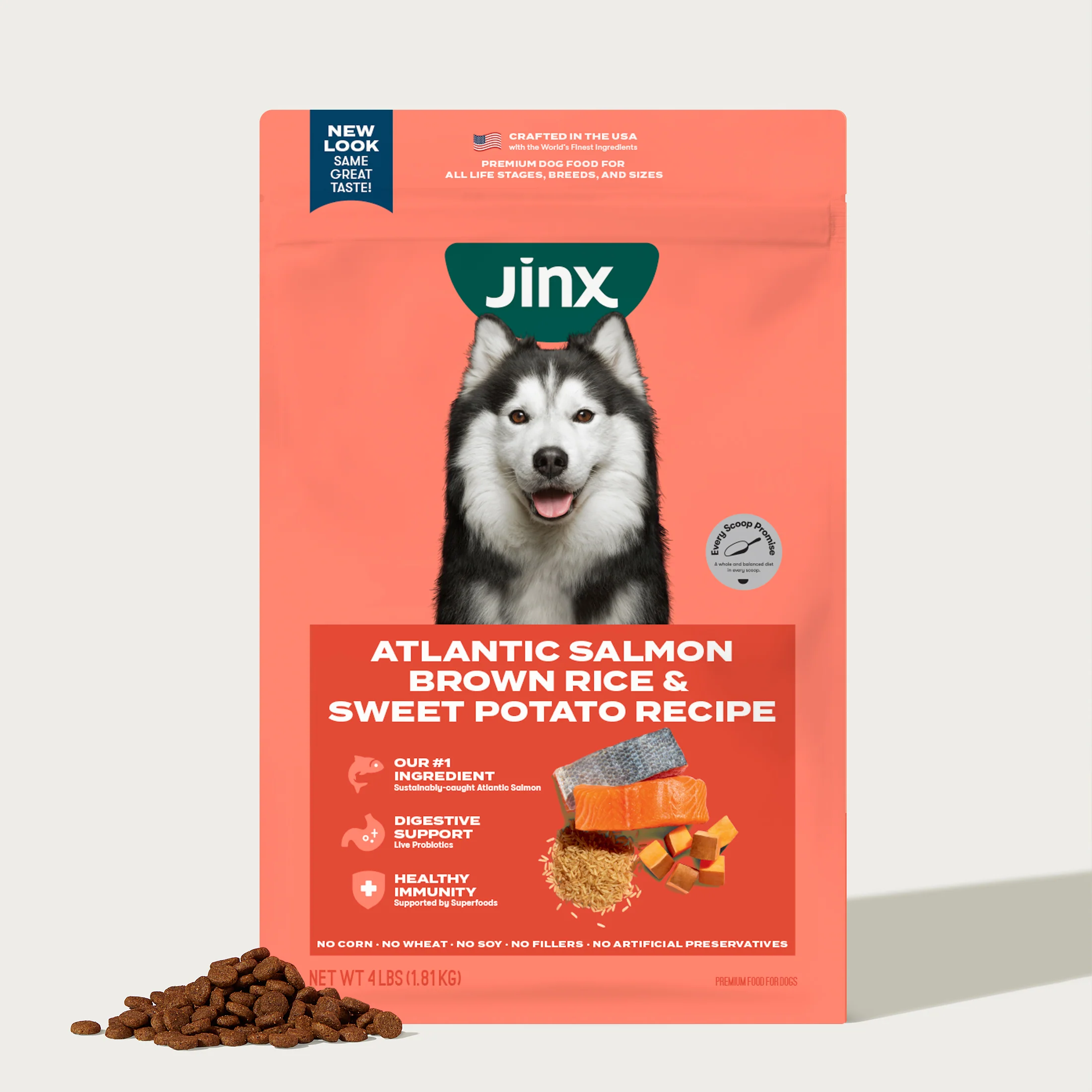
DogFoodAdvisor is reader supported See how
All reviews are 100% impartial but if you buy using links on this page, we may earn a referral fee.
Which Jinx Recipes Get Our Best Ratings?
Jinx dry product range is made up of eight recipes which each receive the Dog Food Advisor’s rating, 5 stars.
The table below shows each recipe in this range including our rating and the AAFCO nutrient profile: Growth (puppy), Maintenance (adult), All Life Stages, Supplemental or Unspecified.
Recipe and Label Analysis
Jinx Atlantic Salmon, Brown Rice and Sweet Potato Recipe was selected to represent the other products in the line for a detailed recipe and nutrient analysis.
Jinx Atlantic Salmon, Brown Rice and Sweet Potato
Estimated Dry Matter Nutrient Content
Protein
Fat
CarbsCarbohydrates
Salmon, pearled barley, ground peas, turkey meal, brown rice, chicken fat (preserved with mixed tocopherols), menhaden fish meal, oat groats, sweet potato, potato protein, dried plain beet pulp, natural flavor, flaxseed meal, whitefish meal, salmon oil, brewers dried yeast, monocalcium phosphate, salt, calcium carbonate, carrots, pumpkin, cranberry, coconut meal, chia, kelp, alfalfa, miscanthus grass, inulin, taurine, choline chloride, minerals (zinc sulfate, ferrous sulfate, copper sulfate, manganous oxide, sodium selenite, calcium iodate), mixed tocopherols (preservative), citric acid (preservatives), vitamins (vitamin E supplement, niacin supplement, l-ascorbyl-2-polyphosphate, vitamin A supplement, thiamine mononitrate, d-calcium pantothenate, pyridoxine hydrochloride, biotin, riboflavin supplement, vitamin D3 supplement, folic acid, vitamin B12 supplement), blueberry, spinach, turmeric, ginger, chamomile, parsley, apple, dandelion, dried spearmint, cinnamon, dried bacillus coagulans fermentation product, rosemary extract
Fiber (estimated dry matter content) = 5%
Red denotes any controversial items
| Estimated Nutrient Content | |||
|---|---|---|---|
| Method | Protein | Fat | Carbs |
| Guaranteed Analysis | 27% | 14% | NA |
| Dry Matter Basis | 30% | 16% | 46% |
| Calorie Weighted Basis | 26% | 33% | 41% |
Ingredients Analysis
The first ingredient in this dog food is salmon. Although it is rich in omega-3 fatty acids, raw salmon contains up to 73% water. After cooking, most of that moisture is lost, reducing the meat content to just a fraction of its original weight.
After processing, this item would probably account for a smaller part of the total content of the finished product.
The second ingredient is pearled barley, a starchy carbohydrate supplying fiber and other healthy nutrients. However, aside from its energy content, this cereal grain is of only modest nutritional value to a dog.
The third ingredient includes ground peas. Ground peas are a good source of carbohydrates. Plus they’re naturally rich in dietary fiber.
However, ground peas contain about 27% protein, a factor that must be considered when judging the meat content of this dog food.
The fourth ingredient is turkey meal. Turkey meal is considered a meat concentrate and contains nearly 300% more protein than fresh turkey.
The fifth ingredient is brown rice, a complex carbohydrate that (once cooked) can be fairly easy to digest. However, aside from its natural energy content, rice is of only modest nutritional value to a dog.
The sixth ingredient is chicken fat. This item is obtained from rendering chicken, a process similar to making soup in which the fat itself is skimmed from the surface of the liquid.
Chicken fat is high in linoleic acid, an omega-6 fatty acid essential for life. Although it doesn’t sound very appetizing, chicken fat is actually a quality ingredient.
The seventh ingredient is menhaden fish meal, another protein-rich meat concentrate.
Menhaden are small ocean fish related to herring. They’re rich in protein and omega-3 fatty acids. What’s more, in their mid-depth habitat, menhaden are not exposed to mercury contamination as can be typical with deep water species.
Fish meal is typically obtained from the “clean, dried, ground tissue of undecomposed whole fish and fish cuttings” of commercial fish operations.1
The eighth ingredient includes oat groats, a whole grain, minimally processed form of oats. With the exception of their caloric content and the fact they’re also gluten free, oat groats can be considered average in nutritional value.
The ninth ingredient is sweet potato. Sweet potatoes are a gluten-free source of complex carbohydrates in dog food. They are naturally rich in dietary fiber and beta carotene.
The tenth ingredient is potato protein, the dry residue remaining after removing the starchy part of a potato.
Even though it contains over 80% protein, this ingredient would be expected to have a lower biological value than meat.
And less costly plant-based products like this can notably boost the total protein reported on the label — a factor that can’t be ignored when judging the actual meat content of this dog food.
The next ingredient is beet pulp. Beet pulp is a controversial ingredient, a high fiber by-product of sugar beet processing.
Some denounce beet pulp as an inexpensive filler while others cite its outstanding intestinal health and blood sugar benefits.
We only call your attention here to the controversy and believe the inclusion of beet pulp in reasonable amounts in most dog foods is entirely acceptable.
From here, the list goes on to include a number of other items.
But to be realistic, ingredients located this far down the list (other than nutritional supplements) are not likely to affect the overall rating of this product.
With eight notable exceptions…
First, flaxseed meal is one of the best plant-based sources of healthy omega-3 fatty acids. Flax meal is particularly rich in soluble fiber.
However, flaxseed contains about 19% protein, which will affect the actual meat content of this food.
Next, brewers yeast can be a controversial item. Although it’s a by-product of the beer making process, this ingredient is rich in minerals and other healthy nutrients.
Fans believe yeast repels fleas and supports the immune system.
Critics argue yeast ingredients can be linked to allergies. This may be true, but (like all allergies) only if your particular dog is allergic to the yeast itself.
In addition, a vocal minority insists yeast can increase the risk of developing the life-threatening condition known as bloat. However, this is a claim we’ve not been able to scientifically verify.
In any case, unless your dog is specifically allergic to it, yeast can still be considered a nutritious additive.
What’s more noteworthy here is that brewers yeast contains about 48% protein, a factor that must be considered when rating this dog food.
In addition, this recipe includes coconut meal, also known as copra meal.
Copra meal is a by-product of coconut oil production and is more commonly found in farm animal feeds.
Although copra meal contains about 25% protein, this ingredient is lower in some essential amino acids. So, its nutritive value is considered inferior to other oil meals (such as soybean meal).
Next, we note the use of chia seed, an edible seed nutritionally similar to flax or sesame. Provided they’re first ground into a meal, chia seeds are rich in both omega-3 fatty acids as well as dietary fiber.
However, chia seeds contain about 17% protein.
This recipe also includes alfalfa, a flowering member of the pea family that is high in protein (18%) and fiber. It is less common to see it used in dog food.
Additionally, taurine is an important amino acid associated with the healthy function of heart muscle. Although taurine is not typically considered essential in canines, some dogs have been shown to be deficient in this critical nutrient.
Since taurine deficiency appears to be more common in pets consuming grain-free diets, we view its presence in this recipe as a positive addition.
We also note the presence of sodium selenite, a controversial form of the mineral selenium. Sodium selenite appears to be nutritionally inferior to the more natural source of selenium found in selenium yeast.
And lastly, the minerals listed here do not appear to be chelated. And that can make them more difficult to absorb. Chelated minerals are usually associated with higher quality dog foods.
Nutrient Analysis
Based on its ingredients alone, Jinx Atlantic Salmon, Brown Rice and Sweet Potato Recipe looks like an above-average dry dog food.
The dashboard displays a dry matter protein reading of 31%, a fat level of 16.3% and estimated carbohydrates of about 39%.
As a group, the brand features an average protein content of 31.1% and a mean fat level of 16.3%. Together, these figures suggest a carbohydrate content of 39.1% for the overall product line.
And a fat-to-protein ratio of about 52%.
Above-average protein. Near-average fat. And below-average carbs when compared to a typical dry dog food.
When you consider the protein-boosting effect of the peas, potato protein, flaxseed, brewers yeast, coconut meal, chia and alfalfa, this still looks like the profile of a kibble containing a notable amount of meat.
Jinx Dog Food Recall History
The following automated list (if present) includes all dog food recalls related to Jinx through April 2025.
No recalls noted.
You can view a complete list of all dog food recalls since 2009 here.
Our Rating of Jinx Dry Dog Food
Jinx includes both grain-free and grain-inclusive dry kibbles. The Jinx product line uses named meat meals as its dominant source of animal protein… thus earning the overall brand 5 stars.
Compare Jinx Dry Dog Food
How does Jinx Dry compare with The Dog Food Advisor's most recommended brands?
A Final Word
The Dog Food Advisor does not accept money, gifts, samples or other incentives in exchange for special consideration in preparing our reviews.
However, we do receive a referral fee from online retailers (like Chewy or Amazon) and from sellers of perishable pet food when readers click over to their websites from ours. This helps cover the cost of operation of our free blog. Thanks for your support.
For more information, please visit our Disclaimer and Disclosure page.







